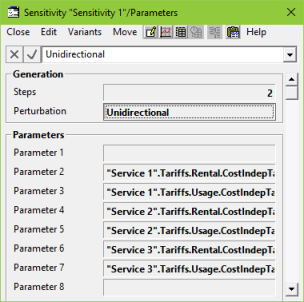By default, when a sensitivity is run, each parameter is varied by 1% up and down, with no intermediate steps. However, you can change this behaviour for all parameters within a particular sensitivity element by changing the
Steps
and Perturbation settings in the Parameters dialog of that element.

Changing how sensitivities are run
Steps: with the default setting of Steps = 1, STEM varies the parameter with no intermediate steps (that is, calculates only one set of sensitivity results in each direction, up and down). However, if you want to examine the impact of the parameter in more detail, you can also generate sets of results for several steps in each direction (up to a limit of 20 steps).
Note: changing the number of sensitivity steps to 2 does not double the maximum range. The number of steps is intended as a measure of detail, whereas the Up and Down values are intended as the overall limit independent of the number of steps.
Perturbation: determines the direction in which the parameter is varied. By default, a parameter is perturbed both up and down (Bidirectional), but you can choose to vary it in a single direction (Unidirectional) – in which case only the Up value is used (note that this value can be entered as a negative figure).
When the value of a parameter is increased or decreased, this is normally calculated as a proportion of the original value (by default
± 1%). In the Details dialog, you can change the basis for this calculation using the Type
input. By setting this to Delta
you can vary the value by a specified fixed amount (for example ± 10,000), or you can define the Absolute
maximum or minimum values that the parameter should take. Note that the Type can be set for each individual sensitivity.